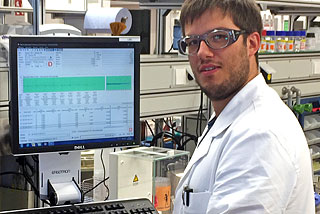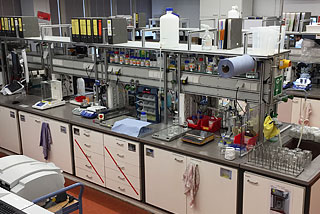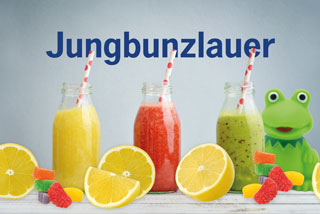
CAQ-Software at Jungbunzlauer: Software Beats Paper
With annual revenue of over 700 million Euros and 1,060 employees in Germany, Austria, Canada, and Switzerland, Jungbunzlauer is one of the international leaders in the field of biologically degradable product ingredients.
The global player was founded in 1867 and can therefore look back on a long and successful tradition. As specialist producer of citric acid, citric acid esters, xanthan, gluconates, lactic acid, mineral salts, sweeteners, and related performance products, Jungbunzlauer supplies the beverage, foodstuffs, pharmaceuticals, and cosmetics industries as well as a variety of technical manufacturing branches. For quality control and assurance operations in the laboratory of the production facility in the German town of Ladenburg, Jungbunzlauer lays its trust in a fully integrated and validated LIMS by CAQ AG.
A Highly Flexible Ingredient

Founded in 1998, the Ladenburg facility with its today over 240 employees is committed to the production of high grade citric acid esters and mineral salts. The scope of activities also includes research and development of application-specific concepts and recipes, as well as complex technical screenings and sensory inspections. Primary raw materials such as citric acid are delivered to Ladenburg by other Jungbunzlauer facilities and processed into products such as tripotassium citrate.
Citric acid is a fruit acid which, for industrial applications, is produced via a fermentation process in which carbohydrates are used as substrate. It is the most frequently used natural sweetener in foodstuffs, beverages, and pharmaceuticals. Because citric acid is also an excellent non-toxic sequestrant, it is also used for innovative applications within a variety of industries.
Global Cross-Industry Requirements
Due to the many applications that its products are used in, Jungbunzlauer must adhere to a variety of international pharmaceutical and foodstuffs standards. Apart from certifications in accordance with general standards such as ISO 9001:2015 for quality management, ISO 14001 for environmental management, and ISO 50001 for energy management, Jungbunzlauer also fulfils additional industry-specific requirements. Said requirements call for meticulously performed and archived analyses in accordance with the Food and Drug Administration (FDA), the Food Chemical Codex (FCC,) the EU-Guideline 231 (2012) or the European Pharmacopoeia (Ph.Eur), and the United States Pharmacopeia (USP). All of these standards and guidelines notoriously bring one thing to the fore: a serious amount of paper.
25,000 Pages per Year
The laboratory in Ladenburg performs an average of 50,000 individual analyses per year. In 2016 alone, more than 2,500 raw material batch inspections and 1,285 finished product batch analyses were performed. In the past this meant that, for instance, all batch-related laboratory inspections were conducted manually and a 25 page-spanning batch document per individual analysis had to be created by hand. Each of said documents then needed to be stamped and approved with around about 30 signatures. All of this added up to 25,000 pages of paper per year that needed to be stored away in countless folders.
The Software Solution: Going the Extra Mile

In 2012, Jungbunzlauer Ladenburg’s head of quality control Dr. Jochen Jung embarked on a search to find a suitable software solution with which to replace the existing paper-based system and thereby help increase the overall process efficiency in the laboratory. After having examined a variety of LIMS (Laboratory Information Management System) and Quality Management Software solutions, the choice fell on the software solution Compact.Net by CAQ AG Factory Systems.
There were several reasons for this choice. From the hardware point of view, one of the decisive factors was the vast flexibility that the software offered with regard to connecting laboratory devices. The APE.Net interface module of the software, for instance, facilitated the direct connection of all devices in the Ladenburg laboratory with the system. Said devices included three titration systems by Xylem (previously SI-Analytics), a NIR by Bruker, HPLC, GC, and AAS by Agilent, photometers by PerkinElmer and Thermo, particle size analyzers by Quantachrome, ph-meters by WTW, various scales and drying balances by Sartorius, Karl-Fischer titration systems by Metrohm as well as densimeters and refractometers by Mettler-Toledo.
A Comprehensive Solution
Jungbunzlauer saw the implementation of a cutting edge software solution as an investment into the future. This is why the modular design of the software suite proved to be a further drawcard. It meant that the Compact.Net solution in the laboratory could be easily expanded by adding additional modules. Apart from offering software solutions for LIMS, records management, and audit-trail, CAQ AG’s portfolio, amongst other, also includes solutions for supplier, training, document, and risk management as well as process, audit, job, gauge, complaint, and maintenance management. All of these additional functions and future application scenarios underlined Jungbunzlauer’s choice pro CAQ AG software
It weren’t however only system-related aspects of the CAQ AG solution that convinced the company. The customer service provided prior to, during, and after the system implementation were of equal importance. Excellent supplier/customer communication during the software introduction and project management phases reassured Jungbunzlauer that the choice of software provider they had made back in 2013 was definitely the right one.
Validated

Because the Jungbunzlauer products are used in the foodstuffs and pharmaceutical sectors, the Software underlies a variety of international regulations such as the FDA’s 21 CFR part 11. This regulation requires that a so-called computer system validation (CSV) is performed for software that is put into place to replace existing paper-based processes. It is basically a documented process that consistently and reproducibly ensures that a computer system does exactly what it is meant to do. The validation team at Jungbunzlauer was able to validate their system together with the support of an external validation specialist within 20 onsite days.
Seamless Change Control Ensures Data Integrity
Aspects such as change control, consistent data monitoring, and FDA-compliant signatures are required in order to ensure compliance and data integrity. The change control and audit trail used in the CAQ AG’s LIMS-Software mean that changes made to records, products, or systems are consistently and comprehensively documented. A separate structure is used in order to record the date/time, username, and workstation when changes are made. This allows Jungbunzlauer to precisely identify when who made what changes where. Hence, the fulfilment of all relevant documentation duties takes place in the background, and, at the touch of a button, all e.g. audit-relevant change information as stipulated by applicable standards and regulations is available.
Fully Integrated
During the LIMS Software implementation, every laboratory table was equipped with a rotatable data acquisition station that consists of a PC on which the CAQ AG software is installed. The laboratory devices were all connected via the interface module APE.Net and the SAP® ERP-system was linked via the standard SAP® interface and the bidirectional interface module Connect.Net. Jungbunzlauer today also achieves comprehensive batch documentation by transmitting all data from the in-process control laboratories and primary driving parameters from the process management system directly into the CAQ AG LIMS-system. In the near future a further automated SAP®-connection will be used to transfer information directly to the SAP certificate generator. As the LIMS is the system in charge of all quality-related information regardless of SAP® material number, it can operate with great efficiency.
An Increase in Efficiency and Transparency

After the switch to the LIMS Software, all batch-related laboratory analyses are now acquired fully electronically, thus replacing the previously manually filled in 25-page batch documents with their 30 odd stamps and signatures. This equates to a massive increase in efficiency and transparency and is even good for the environment – at least 25,000 fewer pages of paper are required per year. The data transparency brought about by digitalizing the previously paper-based system also meant that the effort required for the "four eyes principle" checks and balances mechanism was halved. General availability of data was also improved, as all chromatograms, spectra, and titration curves are now immediately available as PDF-file in the LIMS system.
Future-Proof
Companies in the foodstuffs and pharmaceuticals industry today must grasp the advantages provided by digitalisation and software in order to keep up with the quality expectations of their customers, stay ahead of their competition, and adhere to ever-increasing quality assurance regulations. CAQ AG’s software solutions were developed with precisely these goals in mind and support companies around the globe to increase, monitor, and document the quality and safety of their products. With these sophisticated tools at its disposable, Jungbunzlauer can take a relaxed view into the future of quality and information management: Their system is already there.
Additional Links